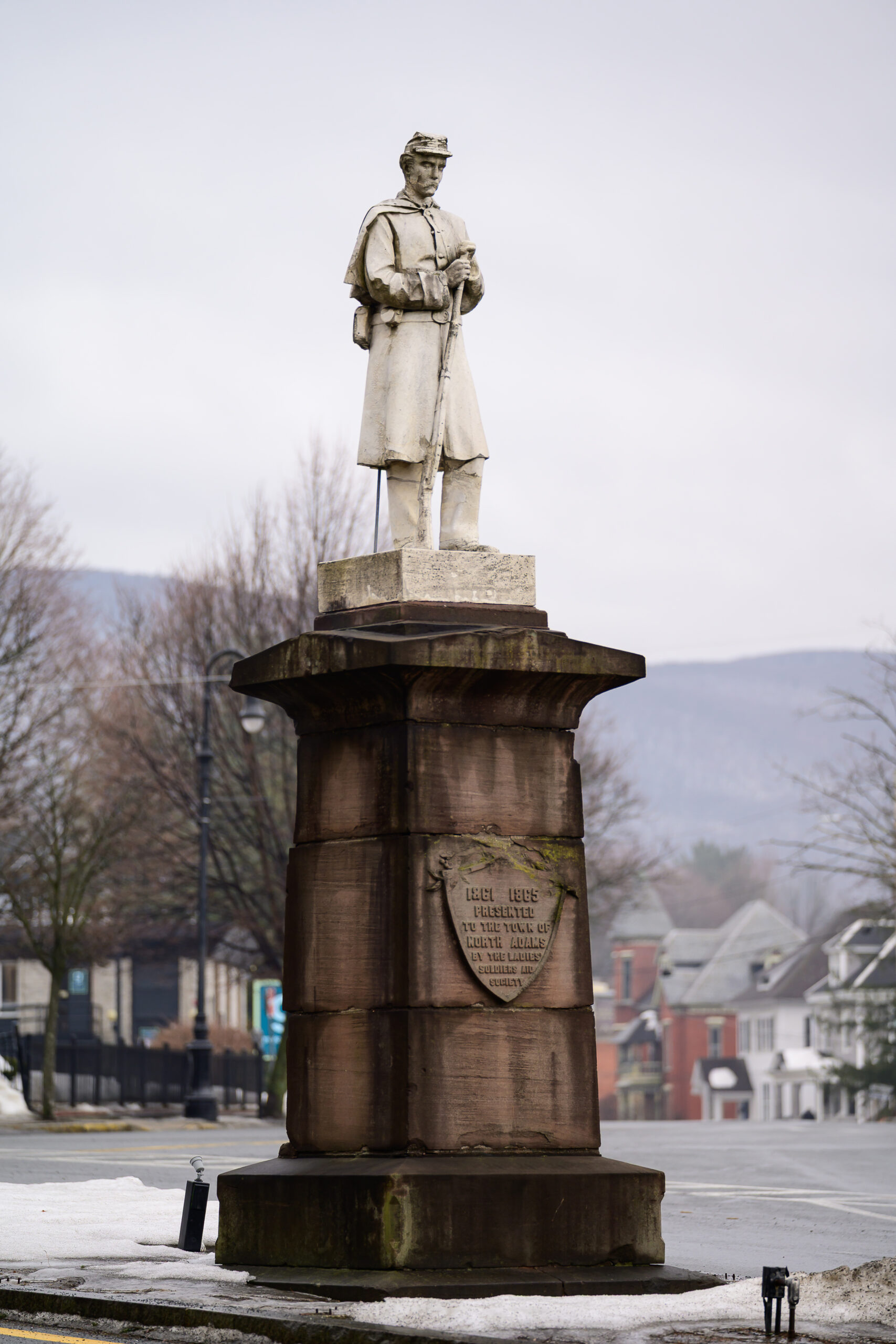
One of my favorite Berkshire monuments is the lone, armed, mustachioed sentinel who stands at parade rest and has manned his post for almost 150 years, watching over generations of North Adams residents.
The statue is located on Monument Square on the corner of Church and Main Street. It was dedicated on July 4, 1878, to all who served during the Civil War. It was reported that over 10,000 people attended the dedication. There were brass bands, a parade, food, and many other festivities.
A gold-star mother, Mrs. Sophronia Sanford, led the effort by the Ladies Soldiers Aid Society. The Society donated $3,000 and collected contributions from citizens and received an appropriation by the town of North Adams. Sophronia was the wife of Miles Sanford, who was pastor of the Baptist Church for almost twenty years. Their son Charles D. Sanford was killed during the war.
The statue was reportedly carved from a 7,000 pound block of Sicilian white marble.* The eleven-foot-high pedestal was made from brownstone from Portland, Maine. The monument with the soldier standing at parade rest is 18 feet tall.
These words are etched in the national shield on the front of the pedestal:
1861-1865
Presented
To the Town of
North Adams
By the Ladies
Soldiers Aid Society
The monument, known for its simplicity and beauty, has stood unchanged through the various transformations of North Adams. From his prominent place, the soldier, facing Main Street, has witnessed North Adams becoming a town then a city and has seen the introduction and removal of trolley cars, the creation of railroads, the rise and fall of textile mills, the building of the Blackinton mansion and the Hoosac tunnel, watched the many people employed at Sprague Electric, the changes and closures of churches, schools, movie theaters, and hotels, and the hotly discussed urban renewal project of the 1970s.
The statue’s creator was sculptor Charles N. Pike (1838-1909), a North Adams native. Charles was born near the Natural Bridge. He worked for his dad, who owned a local marble quarry and was himself a well-known sculptor.
Charles answered President Lincoln’s call for troops and enlisted in the Union Army on June 14, 1861. He served as a hostler and carriage driver in Company B of the 10th Massachusetts Infantry Regiment. In his position, he was tasked with driving Generals McClellan and then Burnside, Hooker, Meade, and Grant.
The solemn statue he created is dressed in an army overcoat, with his forage cap, cartridge box, musket, bayonet scabbard, and belt. It represents the unusually large portion of patriotic men who enlisted in the Civil War from the surrounding towns.
The statue has been knocked down twice. On its 100th anniversary in March 1978 it was struck by a car and then in 1999 it was felled by the City’s Christmas tree during a December storm. Both times Carl Robare from Stamford, Vermont, pieced the statue together. After waterproofing it, the city returned it to its pedestal.
Soldier’s Uniform
The soldier is wearing a greatcoat which would have been made of wool, was sky blue with a collar, had a fixed short cape, and usually reached the knees. It was issued to all soldiers. It provided protection in the coldest weather and could be used as a blanket. When not in use, it was often carried on their knapsacks or turned in during warmer weather. The soldier’s hat was known as the forage cap. His wool trousers would have been light blue with no pockets. The cap was also made of wool and had a leather bill. Soldiers were issued one per year, and the caps often sported brass letters designating the man’s regiment and company.
His shoes were called brogans. Four times a year soldiers were issued a pair of these leather, squared-toed, ankle-high shoes that laced up in the front. The coarse leather was uncomfortable, although thick woolen socks provided some relief. The shoes had no arch support, and there was no difference between the right and left shoes. After wearing the “straight” shoes for some time, they would mold to a soldier’s feet, naturally forming a left and right shoe. Records indicate the shoes were often sucked off the soldier’s feet in muddy conditions. The belt like the soldier is wearing normally had a brass buckle with the letters “US” inscribed on it. The belt held the ammunition for his musket, cartridge, and cap boxes.
Soldiers Weapons
The soldier is wearing a bayonet scabbard. The rifle musket he is holding is likely a .58 caliber Springfield Model 1861, the most common and reliable weapon used by the Union army. This nine-pound weapon was accurate from 200 to 400 yards rifle and cost the government $14.00. These muskets were manufactured at the Springfield Armory in Springfield, Massachusetts, which is about sixty miles from North Adams. The Armory manufactured over 200,000 Springfields during the Civil War.
Epilogue
After the war, the Charles D. Sanford GAR Post 79 was organized in North Adams on March 24, 1869. It was named after Charles D. Sanford, son of Sophronia and Reverend Miles Sanford.
As the war approached, Charles joined the Army as a 1st Lieutenant. Promoted to captain, he was killed at the Battle of Drewry’s Bluff on May 16, 1864, leading his men. The confederates buried his body on the battlefield. His father recovered Charles’ body in 1865. He was reinterred at Hillside Cemetery. At their passing, his mother and father were buried next to him.
The Grand Army of the Republic Hall was constructed at the cost of $30,000 on Holden Street and dedicated in October 1896 by the town’s first mayor, Albert Houghton.
Monument Square was listed on the National Register of Historic Places in 1972.
* While repairing the statue, Carl Robare determined that the statue was not carved from “white Sicilian marble” but from “white Berkshire limestone.”(The Times Record 7-3-81).
Photo Courtesy of Dan Morgan Photography 2025